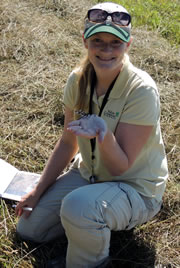My 2013 Christmas Bird Count story: Why I've become a regular CBC participant
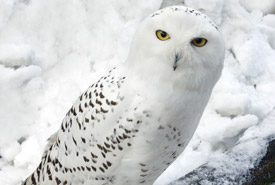
Snowy owl (Photo by Chris Moncrieff)
There is a very cohesive feeling that comes with participating in a Christmas Bird Count. For more than 100 years, citizens across the Americas have been coming together between December 14 and January 5 to spy, spot, listen for, photograph and count birds. The results are part of one of the largest and longest running tally of biodiversity information available in the world and help scientists understand trends in bird populations over time and geography.
Knowing I’m part of something much, much bigger than myself and my binoculars is one of the most exciting things about participating in a Christmas Bird Count. Though when the day comes, it’s really all about the unique bird treasure hunt that ensues!
The counts bring novice, amateur and expert birders together. In my local count circle in Guelph, Ontario, I am somewhere between a novice and an amateur. All that counts is following your senses and spotting those birds.
The 2013 Guelph Christmas Bird Count
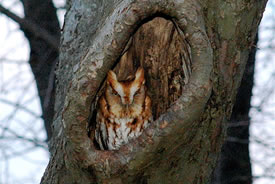
Eastern screech owl (Photo by Wikimedia Commons, Epeterwolf)
This year it was a cold, blustery, windy and unexpectedly snowy Sunday, December 15 when I gathered with fellow birders in a dark parking lot at 6:15 a.m. We set out owling, as the darkness that would soon dissipate is the only time during our 12-hour window that might let us hear an owl. Playing a the horse-like cackle of an eastern screech owl into the dark stillness of a coniferous forest as the sun began to streak the horizon was a great success, when a pair of owls cackled back to us with gusto. The day was off to a fine start.
We hiked and drove for nearly 12 hours. We covered all types of landscapes within our portion of Guelph’s count circle and were rewarded with unique finds at every stop. Wandering along a tributary of the Speed River that wasn’t completely frozen over got us our only great blue heron of the day. Peeking into someone’s bird feeder in their backyard yielded a glimpse of a count rarity — a chipping sparrow. Zipping our car down a snowy country road revealed a flock of nearly 100 snow buntings. A hike through a forest got us a downy woodpecker, hairy woodpecker and white-breasted nuthatch all in one cluster of trees.
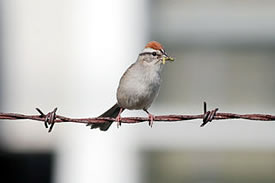
Chipping sparrow (Photo by Wikimedia Commons, Dori)
Unfortunately, we “dipped” (a birder term for missing a bird you’re specifically looking for) on the much-anticipated snowy owl, which had been reported hanging around the development site for a new Costco over the previous week. I asked our team captain Kyle why that habitat was better for the owl than, say, the forest down the road, and he answered that an industrial site, barren but for dirt, snow and occasional mounds, was actually a close replica of the snowy owl’s northern hunting grounds on the Arctic tundra.
I don’t regret a minute of my high-speed sprint across the "tundra," binoculars in hand, breath fogging in front of me on that -15 degree day where the wind whipped across my cheeks but kept my subject hidden from sight. It was exhilarating, and I know I’ll find that owl sometime this winter!
The snowy owl invasion
Snowy owls have become quite a phenomenon in southern Ontario, and across much of Canada and the U.S. this year. An "invasion" of snowy owls has left it not uncommon to find one perched on a fencepost during an otherwise ordinary drive to work. The influx is thought to be linked to the predator-prey cycles of owls, though the exact reasons are still unknown.
The Nature Conservancy of Canada's (NCC’s) President and CEO, John Lounds, who participated in a Christmas Bird Count on Long Point the same weekend as my outing, also spent some time tracking snowy owls to no avail. Accepting defeat, his group headed out of the field for the day, only to be dazzled by a snowy owl flying by as they left. I like to think he gave a wise, owlish wink as he flew overhead.
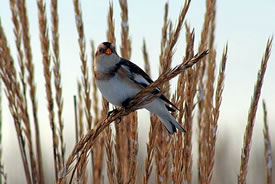
Snow bunting (Photo by Wikimedia Commons, John Haslam)
You too can be a citizen scientist!
Citizen science monitoring is an unspeakably important part of conservation and I would encourage anyone who hasn’t tried it out yet to get involved. Christmas Bird Counts in particular are a great excuse to catch some sunshine and exercise during the dark, sedentary months of winter, and for me a great way to learn even more bird species (which I then can point out in delight at my own feeders all winter long!). Check out the Audubon or Bird Studies Canada websites to find a count near you.
If you’re more of a fair weather scientist, consider getting involved in some of NCC’s own citizen science initiatives this summer. In June and July we’ll be hosting butterfly and/or dragonfly counts in the Minesing Wetlands and Carden Alvar areas and would love to have some new faces along for the journey. Check out the Conservation Volunteers website to sign up this spring and see what you help us find.
Happy holidays, and good birding!

